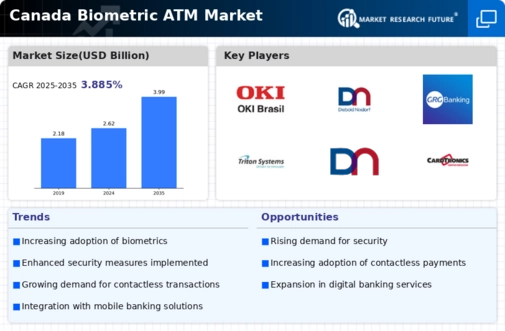The biometric ATM market in Canada is characterized by a dynamic competitive landscape, driven by technological advancements and increasing consumer demand for secure banking solutions. Key players such as NCR Corporation (US), Diebold Nixdorf (US), and Fujitsu (JP) are at the forefront, each adopting distinct strategies to enhance their market presence. NCR Corporation (US) focuses on innovation, particularly in integrating biometric technologies with existing ATM systems, thereby improving user experience and security. Meanwhile, Diebold Nixdorf (US) emphasizes partnerships with financial institutions to expand its service offerings, positioning itself as a leader in digital banking solutions. Fujitsu (JP) is leveraging its expertise in biometric authentication to develop advanced ATM systems that cater to the growing need for secure transactions, thus shaping a competitive environment that prioritizes technological integration and customer-centric solutions.
In terms of business tactics, companies are increasingly localizing manufacturing and optimizing supply chains to enhance operational efficiency. The market appears moderately fragmented, with several players vying for market share. This fragmentation allows for diverse offerings, yet the collective influence of major companies like NCR Corporation (US) and Diebold Nixdorf (US) creates a competitive pressure that drives innovation and service enhancement across the sector.
In October 2025, NCR Corporation (US) announced a strategic partnership with a leading Canadian bank to deploy a new line of biometric ATMs equipped with facial recognition technology. This move is significant as it not only enhances security but also aligns with the bank's digital transformation strategy, potentially increasing customer engagement and satisfaction. The partnership underscores NCR's commitment to innovation and its ability to adapt to the evolving needs of financial institutions.
In September 2025, Diebold Nixdorf (US) launched a new software platform designed to integrate seamlessly with its biometric ATMs, allowing for real-time data analytics and enhanced security features. This initiative is crucial as it positions Diebold Nixdorf to offer more personalized banking experiences, thereby attracting a broader customer base. The integration of advanced analytics into ATM operations may also lead to improved operational efficiencies for banks, further solidifying Diebold Nixdorf's competitive edge.
In August 2025, Fujitsu (JP) unveiled a new biometric ATM model that incorporates multi-modal biometric authentication, including fingerprint and iris recognition. This development is particularly noteworthy as it addresses growing concerns over security and fraud in financial transactions. By offering a more robust authentication process, Fujitsu is likely to enhance its market position and appeal to banks seeking to bolster their security measures.
As of November 2025, the competitive trends in the biometric ATM market are increasingly defined by digitalization, sustainability, and the integration of artificial intelligence. Strategic alliances among key players are shaping the landscape, fostering innovation and enhancing service delivery. The shift from price-based competition to a focus on technological advancement and supply chain reliability is evident, suggesting that future differentiation will hinge on the ability to innovate and respond to consumer demands effectively.


















Leave a Comment